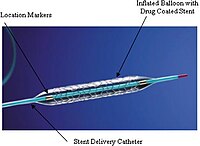
Photo from wikipedia
BACKGROUND The impact of coronary artery disease (CAD) and revascularization on outcome in patients undergoing transcatheter aortic valve implantation (TAVI) has not been fully elucidated so far. OBJECTIVES To assess… Click to show full abstract
BACKGROUND The impact of coronary artery disease (CAD) and revascularization on outcome in patients undergoing transcatheter aortic valve implantation (TAVI) has not been fully elucidated so far. OBJECTIVES To assess whether the degree of CAD influences the prognosis of patients undergoing TAVI. METHODS Before TAVI, all patients underwent revascularization of the proximal vessels or the left main stem if indicated (stenosis ≥70% or 50%, respectively). In 666 patients, we calculated the baseline (bSS) and residual SYNTAX Score (rSS) prior to TAVI. In patients with revascularization, we determined the SYNTAX Revascularization Index (SRI=(1-(rSS/bSS))∗100). We also assessed the SYNTAX Score II (SS-II), combining anatomical and clinical variables. The primary endpoint was 3-year all-cause mortality. RESULTS Higher baseline and residual SYNTAX Score were associated with increased 3-year mortality (no CAD 26.2%, low bSS 34.8%, high bSS 46.8%; p=0.001, respectively, no CAD 25.9%, low rSS 31.4%, high rSS 41.5%; p=0.01). The extent of revascularization represented by the SRI was not associated with outcome. The SYNTAX Score II was also associated with increased 3-year mortality. However, baseline and residual SYNTAX Score as well as SYNTAX Score II did not independently predict mortality. CONCLUSION The anatomic severity of CAD as assessed by the baseline and residual SYNTAX Score is associated with survival after TAVI. Coronary artery disease seems to reflect general comorbidity burden and is associated with a higher risk profile of the patient.
Journal Title: International journal of cardiology
Year Published: 2017
Link to full text (if available)
Share on Social Media: Sign Up to like & get
recommendations!